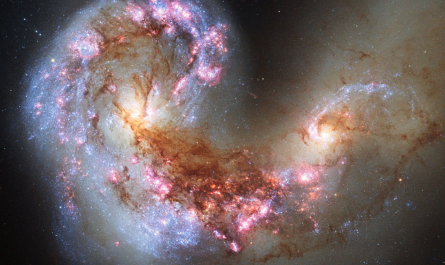
Curious Kids is a series for children of all ages. If you have a question you’d like an expert to answer, send it to curiouskidsus@theconversation.com.
Where does the universe expand if it is already infinite? – Mael, age 10, Missoula, Montana
If you are baking a loaf of bread or several muffins, pour the dough into a mold. As the dough bakes in the oven, it expands in the baking pan. Any chocolate chips or blueberries in the muffin batter will become further apart as the muffin batter expands.
The expansion of the universe is similar in some ways. But this analogy gets one thing wrong: While the dough expands into the baking pan, the universe has nowhere to expand to. It just expands into itself.
It can feel like a brain teaser, but the universe is viewed as everything within the universe. There is no pan in the expanding universe. Just dough. Even if there was a pan, it would be part of the universe and therefore would expand with the pan.
Even for me, a teaching professor of physics and astronomy who has studied the universe for years, these ideas are difficult to understand. You don’t experience something like that in everyday life. It’s like asking which direction is further north of the North Pole.
Another way to think about the expansion of the universe is to think about how other galaxies are moving away from our galaxy, the Milky Way. Scientists know the universe is expanding because they can track other galaxies as they move away from ours. They define expansion by the speed at which other galaxies are moving away from us. This definition allows them to imagine expansion without needing something to expand into.
The expanding universe
The universe began with the Big Bang 13.8 billion years ago. The Big Bang describes the origin of the universe as an extremely dense, hot singularity. This tiny point suddenly experienced a rapid expansion called inflation, in which every place in the universe expanded outward. But the name Big Bang is misleading. It wasn’t a huge explosion as the name suggests, but rather a time when the universe was rapidly expanding.
The universe then rapidly condensed, cooled, and began producing matter and light. Eventually it evolved into what we know today as our universe.
The idea that our universe is not static and could expand or contract was first published in 1922 by physicist Alexander Friedman. He confirmed mathematically that the universe is expanding.
While Friedman proved that the universe was expanding at least in some places, it was Edwin Hubble who delved deeper into the rate of expansion. Many other scientists confirmed that other galaxies were moving away from the Milky Way, but in 1929 Hubble published his famous paper confirming that the entire universe was expanding and that the rate at which it was expanding was increasing.
This discovery continues to puzzle astrophysicists. What phenomenon allows the universe to overcome gravity and hold it together while simultaneously expanding by pulling objects in the universe apart? And what’s more, the rate of expansion increases over time.
Many scientists use an image called an expansion funnel to describe how the expansion of the universe has accelerated since the Big Bang. Imagine a deep funnel with a wide rim. The left side of the funnel – the narrow end – represents the beginning of the universe. As you move to the right, you move forward in time. Cone expansion represents the expansion of the universe.

Scientists have not been able to directly measure where the energy causing this accelerated expansion comes from. They couldn’t detect it or measure it. Since they cannot see or directly measure this type of energy, they call it dark energy.
According to the researchers’ models, dark energy must be the most common form of energy in the universe, accounting for about 68% of the total energy in the universe. The energy from everyday matter that makes up the Earth, the Sun, and everything we see makes up only about 5% of the total energy.
Outside the expansion funnel
So what’s outside the expansion funnel?
Scientists have no evidence of anything outside our known universe. However, some predict that there could be multiple universes. A model that spans multiple universes could solve some of the problems scientists are encountering with current models of our universe.
A major problem with our current physics is that researchers cannot integrate quantum mechanics, which describes how physics works at very small scales, and gravity, which governs physics at large scales.
The rules governing the behavior of matter at small scales depend on probability and quantized or fixed amounts of energy. On this scale, objects can emerge and disappear again. Matter can behave like a wave. The quantum world is very different from the way we see the world.
On large scales, which physicists call classical mechanics, objects behave as we expect them to in everyday life. Objects are not quantized and can have continuous amounts of energy. Objects do not appear or disappear.
The quantum world behaves like a light switch where energy can only be turned on and off. The world we see and interact with acts like a dimmer switch, allowing for all energy levels.
But researchers run into problems when they try to study gravity at the quantum level. On a small scale, physicists would have to assume that gravity is quantized. However, the research conducted by many of them does not support this idea.

One way to make these theories work together is the multiverse theory. There are many theories that look beyond our current universe to explain how gravity and the quantum world work together. Leading theories include string theory, brane cosmology, loop quantum theory, and many others.
Regardless, the universe will continue to expand, with the distance between the Milky Way and most other galaxies increasing over time.
Hello, curious children! Do you have a question that you would like an expert to answer? Ask an adult to send your question to CuriousKidsUS@theconversation.com. Please tell us your name, age and the city where you live.
And since curiosity has no age limit – adults, let us know what you’re wondering too. We won’t be able to answer every question, but we will do our best.
This article was republished from The Conversation, a nonprofit, independent news organization that brings you facts and trusted analysis to help you understand our complex world. It was written by: Nicole Granucci, Quinnipiac University
Read more:
Nicole Granucci does not work for, advise, own shares in or receive funding from any company or organization that would benefit from this article, and has disclosed no relevant affiliations beyond her academic employment.

